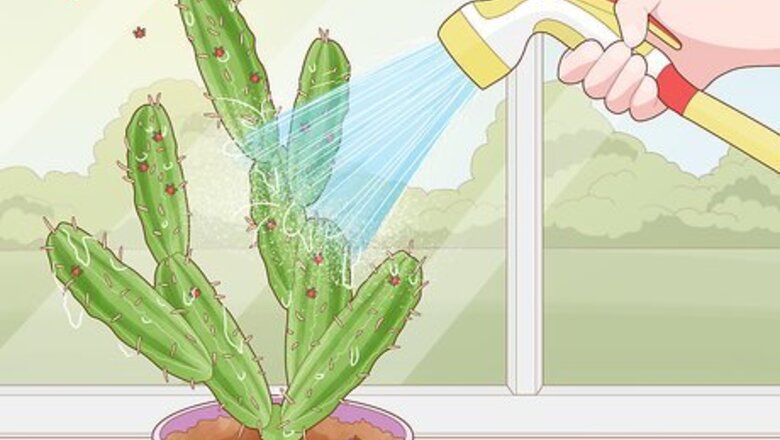
views
Trying Natural Methods
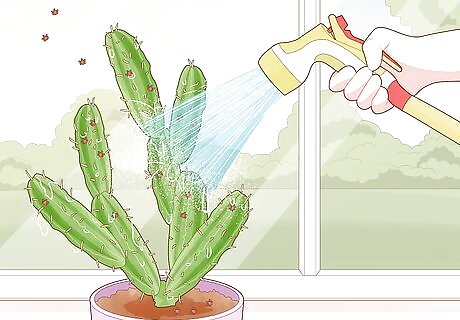
Spray bugs off the plant with your garden hose. Physical removal is the best initial treatment for bug infestations. As soon as you notice bugs on your cactus, set your garden hose to a stream setting. Spray down the entire plant to blast off any bugs crawling on the surface. Don’t set the hose so high that it damages the plant. Spray the stream on one spot for a few seconds to make sure the plant doesn’t tear or break off. If not, keep that pressure for the rest of the plant. An early spray with the hose can stop bugs before they infest the plant. Do this treatment every few days to remove potential pests.

Pick off longhorn beetles with a pair of tweezers. These large beetles are easy to see and rarely cause large infestations, so physical removal should keep them away. If the blast of water doesn’t get rid of them all, take a pair of tweezers and pick each beetle off. Throw them in the trash so they don’t re-infest your plants. Longhorn beetles are most active in the early morning and late evening, the cooler parts of the day. Look for them on your plants during these times. Use thick gloves while checking your plants to protect yourself from the cactus’ spines.
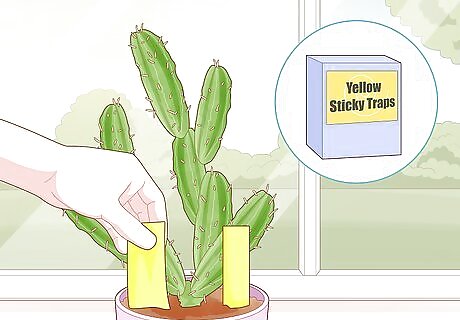
Place yellow sticky traps around the cactus to catch gnats. Fungus gnats hover above the cactus soil, and their larva feed on the roots. Keep them away from the plant with yellow sticky traps. These are sticky strips of paper that attract and catch flying insects. Hang them horizontally close to the soil to deal with a gnat problem. Fungus gnats look like small black mosquitoes. Sticky traps are available at hardware stores or online.
Using Chemical Treatments
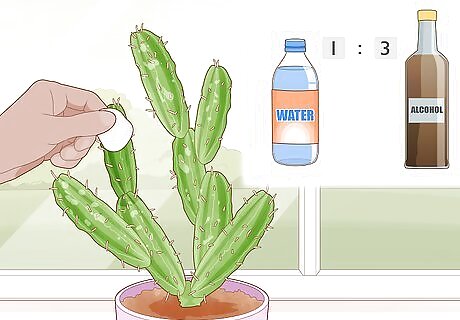
Spot-treat small infestations with a cotton swab and alcohol. If physical removal hasn't worked and the infestation doesn't cover the whole plant, then a quick treatment with alcohol can kill the pests. Mix 3 parts rubbing alcohol with 1 part water. Then, dip a cotton swab into that mixture and rub it on any spots that the bugs have colonized. This treatment is best for small infestations of mealybugs and scale insects. Both attach themselves to the cactus in small colonies. Some cacti are sensitive to alcohol. Treat a small spot first and let it sit for a day. If you see any discoloration or drying out, then don't use alcohol on your cactus.
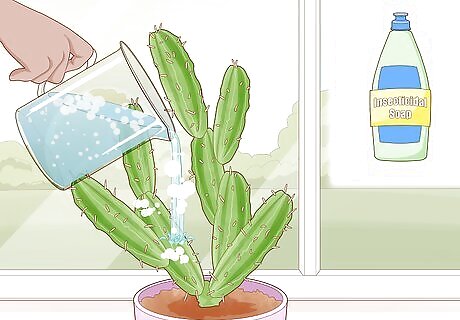
Wash the plant with insecticidal soap if the problem persists. Insecticidal soap is a weaker type of pesticide that kills insects without damaging plants. If physical removal didn’t stop the bugs from infesting your plants, get a type of insecticidal soap designed for use on cacti. Apply the soap exactly as the product instructs you to. Repeat the treatment until the infestation is gone. You can use neem oil instead of insecticidal soap if you prefer. Soaps are most useful for smaller insects like mites, which are hard to remove physically. Most insecticidal soaps instruct you to dilute the product in a spray bottle with water before applying it. Check that any product you use is safe for use on cacti. These may be marked as “ornamental” to indicate that it’s meant for ornamental plants.
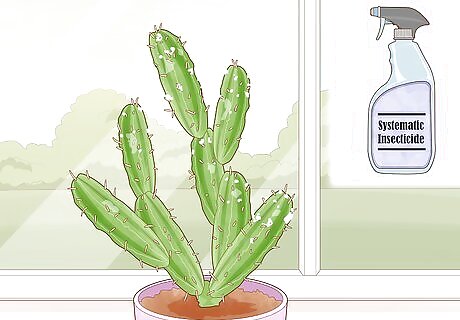
Apply systematic insecticide if you have a mealybug infestation. Mealybugs are especially difficult to get rid of, and will probably require a pesticide treatment. Find a pesticide that’s safe for use on cacti or ornamental plants. Follow the application directions on the product and continue application until the infestation is gone. Mealybugs are about ⁄3 inch (0.85 cm) long and have a cotton-like appearance. The signs of a mealybug infestation are lines of shiny slime that may develop black mold. You can also use insecticides for other insects besides mealybugs. Any bug infestation that won’t go away needs pesticide treatment. Test the insecticide on a small part of one plant to make sure it’s safe. If a day goes by and you notice discoloration or drying, don’t use this product.
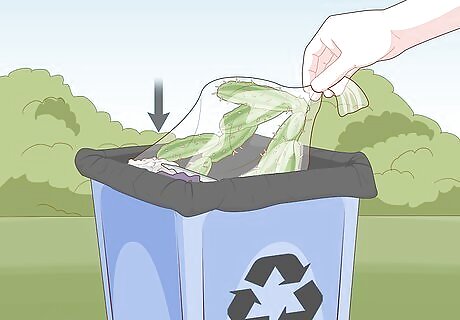
Remove and destroy the plant if you can’t control the infestation. If pesticides still don’t get rid of the infestation, then the plant is probably beyond saving. For the sake of your other plants, remove the infected cactus. Dig the plant out or cut it off at the soil level. Place it in a garbage bag and seal it tightly, then dispose of it in the trash. This step will prevent the bugs from spreading throughout your whole garden. Wear gloves while removing a cactus so you don’t injure yourself. If the cactus spines puncture the bag, then double-wrap the bag to prevent the bugs from escaping. Remember to dig up the plant’s roots as well. Some insect types can infest the roots and live in the soil after the plant is removed.
Preventing Bug Infestations

Quarantine new cacti for 2-3 weeks to avoid introducing pests to your garden. Bugs are often brought to gardens on new plants. If you buy a new cactus, don’t place it near your old plants right away. Keep it away from your main garden for 2-3 weeks and check it daily for bug infestations. If you don’t see any signs, then you can introduce it into your garden. If you bought a potted cactus, consider leaving it inside or on your patio before planting it. When 3 weeks have passed and the plant doesn’t show any signs of a bug infestation, it’s safe to replant with your other plants. If you do notice signs of a bug infestation, you might be able to return it where you bought it.

Follow all the care instructions for your cactus type. Strong plants can resist bug infestations much better than weak ones. Raising your plants properly can prevent a recurrence of bug problems. Different cactus types have different care requirements, so follow all the recommendations for the species you have. This will help keep your plant strong so it is less susceptible to bugs and diseases. Normal cactus care is usually not complicated. The biggest rule is to never overwater the plant. Too much water weakens the plant and makes it more vulnerable to mold or fungus. Make sure your plant gets plenty of sun as well. This helps the plant grow and also dries up moisture that could cause mold.
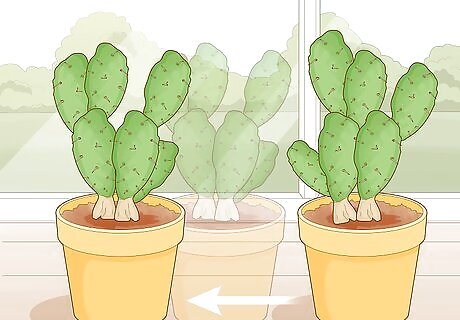
Space plants out so it’s difficult for bugs to travel between them. Bug infestations usually spread when plants are touching. When you’re planting cacti, place them at least 1 inch (2.5 cm) apart so bugs can’t easily crawl from one plant to another. This won’t prevent all infestations, but makes it harder for them to spread. This rule goes for other plants as well. Keep them about 1 inch (2.5 cm) away from cacti to prevent cactus bugs from reaching them.

Clean debris from the base of your plants to remove bug hiding places. Dead leaves give bugs a place to hide and travel between plants. Maintain good hygiene in your garden by raking around your plants to remove any debris. Place these remnants in a compost pile or dispose of them in a garbage can. Wear gloves when cleaning around cacti. Spines might have detached and could cut you. Removing debris is also important for preventing mold growth. Mold infections can weaken the cactus and make it more susceptible to bug infestations.
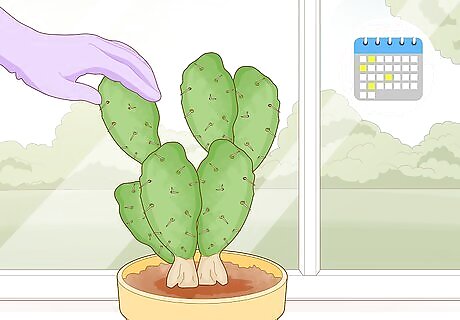
Conduct weekly inspections to check your plants for bug infestations. Catching bug infestations early is the best way to stop them from getting out of hand. Investigate your cacti at least one per week. If you see any signs of an infestation, take the necessary steps to kill the bugs and save the plant. Signs of an infestation include bugs crawling on the plant, sticky clear residue on the plant surface, holes or bite marks, and signs of rotting or drying out.




















Comments
0 comment